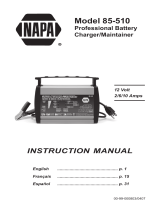
7
The SG becomes higher as the ratio of acid to water changes
back to mostly acid. Measuring SG can only be performed on a
Conventional battery because it has fi ller caps that allow access
to the electrolyte. Other types of batteries without fi ller caps
require a different method to determine state-of-charge.
When a battery discharges, and the SG changes to more
water and less acid, a chemical by-product called lead sulfate
is produced and starts the process of coating the cell plates
reducing the surface area over which chemical reactions
producing current occur. This is the reason that an engine’s
starter motor can’t be cranked indefi nitely, as well as other
electrical loads left on for long periods of time without the
battery going dead. Although this process is normal within
the battery during discharge, a timely recharge is required to
reverse the process and increase the usable surface area of the
plates. Without battery charging, the lead sulfate will continue
to develop and it becomes diffi cult, if not impossible, to break
down. If the battery becomes too discharged, total failure of
the battery is likely as the lead sulfate cannot be removed no
matter how much the battery is charged.
Corrosion and Freezing. Besides sulfation concerns, many
other detrimental actions are taking place inside the battery
while in a discharged condition. The corrosive effect, caused
by acid on the lead plates and connections within the battery,
is greatly increased due to the reduced specifi c gravity of the
electrolyte. In addition, the corrosion of the plates can result
in a gradual reduction in battery performance over time.
Corroded connectors may have suffi cient integrity to support
low drain accessories such as lights and instruments, but may
lack the necessary strength to provide a pathway for the high
discharge current required to start an engine. If the corrosion
is bad enough, it may cause the inter-cell connectors and the
connecting welds to fail. This creates an open circuit within the
battery resulting in sudden battery failure. Another condition
that frequently occurs in a discharged battery is freezing of the
electrolyte. In a deeply discharged battery, the electrolyte has
a reduced specifi c gravity resulting in a higher percentage of
water than sulfuric acid. During this condition, the battery may
freeze at temperatures as high as
32° F (0° C). The electrolyte
in a fully charged battery will not freeze in temperatures well
below
0° F, even down to -75° F. In fact Yuasa batteries have a
suggested operating temperature range between:
14° F to 140°
F (-10° C to 60° C).
Battery Safety
Any device that stores energy can be dangerous. There is a lot of
explosive power in a gallon of gasoline, but when handled with
some knowledge its use can be made relatively safe. Batteries
are no different in that with the proper precautions and safety
practices, they can be handled in a safe manner. Working with
batteries poses two hazards: potentially explosive gases that
are given off during discharging and charging, and sulfuric acid,
which is highly corrosive. The following is an 8-point safety list
that will help keep these two hazards under control:
1. ABSOLUTELY NO SMOKING, SPARKS (FROM STATIC
ELECTRICITY OR OTHER SOURCES) OR OPEN FLAMES
AROUND OR NEAR BATTERIES. Batteries can produce
hydrogen gas that is highly fl ammable when combined with
oxygen; if these gases ignite the battery case can rupture
or explode.
2. On Conventional batteries, loosen vent caps when
charging and ventilate the entire charging area. A
build-up of hydrogen and oxygen levels within the battery, or
in the area where it’s being charged, can create a fi re hazard.
3. If a battery feels hot to the touch during charging, stop
charging and allow it to cool before resuming. Excessive
heat damages the plates, and a battery case that’s too hot
during charging can rupture.
4. On Conventional batteries, REMOVE THE RED SEALING
CAP FROM THE VENT ELBOW. Never put the red sealing
cap back on the battery once it is removed. If sealing cap is
left on, gases trapped inside the battery can explode. For
the same reason, make sure the vent tube isn’t kinked or
blocked. See illustration on page
15.
5. Properly connect battery chargers leads to the battery:
positive to positive, negative to negative. Unplug the
charger, or turn it off before connecting or disconnecting
the leads. This will minimize the chance of creating sparks
when connecting or removing the leads from the battery.
6. Always wear eye protection, protective gloves and
protective clothing when handling a battery.
7. Clean up acid spills immediately, using a water and baking
soda solution to neutralize battery acid (
1 lb. baking soda in
1 gal. water).
8. Make sure battery acid fi ll containers are clearly marked
and work areas are well lighted. If sulfuric acid is
swallowed or splashed in the eyes, take immediate
action. Sulfuric acid in the eyes can cause blindness. While
the diluted sulfuric acid used as electrolyte can burn the
skin, this type of injury is generally less serious. Ingesting,
or swallowing sulfuric acid can cause serious internal
injuries or death.
Remedies for contact with sulfuric acid:
■ External – fl ush with water
■ Internal – drink large quantities of milk or water, followed
by milk of magnesia, vegetable oil or raw, beaten eggs. Call
a poison control center or doctor immediately
■ Eyes – fl ush for several minutes with water, get immediate
medical attention
























